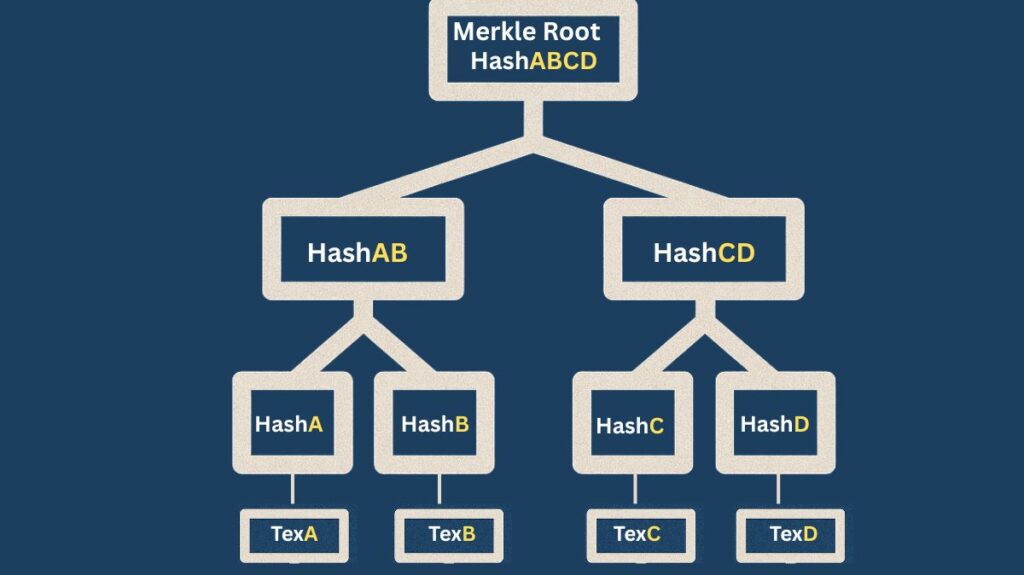Merkle Root in blockchain

A key idea in data integrity and blockchain technology, a Merkle root is a potent cryptographic tool for effectively condensing and validating big databases.
What is a Merkle Root?
The cryptographic hash at the very top of a Merkle tree is known as a Merkle root. It functions as a single, fixed-length digital fingerprint or digest that accurately captures every piece of information in the whole tree. This indicates that it is the most recent descendant of all hashed data blocks or transactions in a system.
Formation and Structure (Merkle Tree)
A Merkle tree, which is usually represented as an upside-down binary tree and is built from the bottom up, is used to create the Merkle root.
Leaves (Bottom Nodes)
The tree’s lowest level is where building starts. Here, data blocks or individual parts are hashed first. These ‘leaves’ often stand in for the hashes of each transaction within a block in a blockchain scenario.
Parent Nodes
Parent nodes are made by combining the hashes of their child nodes in an upward direction. Concatenating the child hashes and hashing the resulting string are the steps involved in this procedure. To make sure each hash has a pair for the hashing procedure, the last hash is duplicated if there are an odd number of hashes at any level. Iteratively, the concatenated child node hashes are re-hashed.
Merkle Root
Until just a single hash is left at the very top of the tree, this iterative pairing and hashing process keeps going. The Merkle root is this last hash.
Goals and Advantages
Due to a number of significant benefits, the Merkle root is essential, particularly in blockchain technology:
Data Security and Detection of Tampering
- For every piece of data in the tree, the Merkle root serves as a distinct digital fingerprint.
- Any leaf-level data change, no matter how small, will result in a different hash. The Merkle root itself will eventually alter as a result of this modification cascading upstream and influencing all parent hashes connected to it.
- Any data in the block can be tampered with quickly and effectively to this cascade effect. The block is invalidated and rejected if a computed Merkle root differs from a stored one, which instantly suggests that the contents has been changed. This process is essential to maintaining the blockchain’s integrity and immutability.
Also Read About What Is A Hash Pointer In BlockChain Data structure Basics’
Effectiveness
- Storage: Because Merkle trees only need to store or verify the fixed-length hashes of data rather than the complete big datasets, they are incredibly efficient for storage. This indicates that they take up relatively little room.
- Verification: The calculation time for verification is greatly decreased by the Merkle root. Instead of examining every single piece of data, the integrity of a whole dataset can be confirmed by comparing its single Merkle root to a known root.
- For instance, in Bitcoin, all transactions within a block may be efficiently verified since full nodes include the Merkle root in the block header.
- A Merkle proof, sometimes referred to as a Merkle path or Merkle branch, is used to validate a particular data block. Only the hashes needed to recalculate the Merkle root from that specific data block are included in this proof. These Merkle roots and branches can be used by light software clients (SPV clients) to validate individual transactions without downloading the complete blockchain.
- Bandwidth: Because the proofs required for data verification are short, they can be sent quickly over a network, guaranteeing bandwidth efficiency.
Applications and Blockchain Integration
Merkle roots are frequently used in peer-to-peer networks and blockchains, among other systems where data integrity is crucial.
Blockchain Structure
The hash of the previous block, a nonce, and the Merkle root of every transaction in the current block are among the important details found in the block header of a standard block structure. Chain immutability depends on this linkage since any changes to the data will cause the block’s Merkle root to change, which will then not match the “Hash of previous block” put in the block after it, breaking the chain.
Bitcoin
Anyone can check the transactions without downloading the complete block since the Merkle root of every transaction in a block is kept in the block header.Ethereum: In technical terms, the Ethereum blockchain is a Merkle Patricia tree [MPT]. Three separate Merkle Patricia treesone for transactions, one for receipts (which display the impact of each transaction), and one for the state (all account information) have roots in each Ethereum block header. These roots are used by miners to quickly respond to requests, including verifying if a transaction was part of a block or determining the current amount of an account.
Solana
The root is released after a Merkle hash is calculated using a chosen Proof of History (PoH) hash appended to every data slice.
Support for Decentralization
The foundation of all blockchains, including well-known ones like Bitcoin and Ethereum, is Merkle trees. They play a key role in allowing decentralized systems to keep an accurate and safe record of data over a dispersed network.
